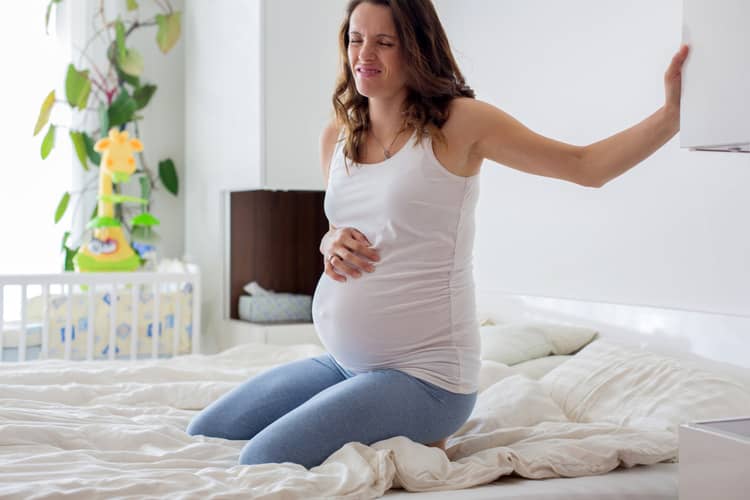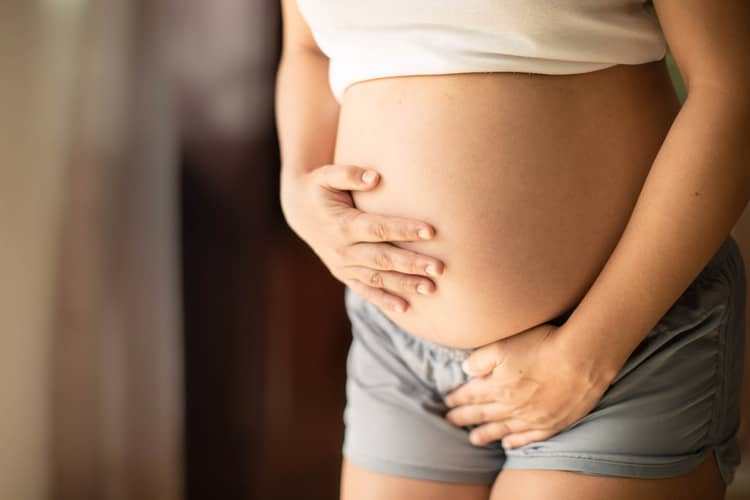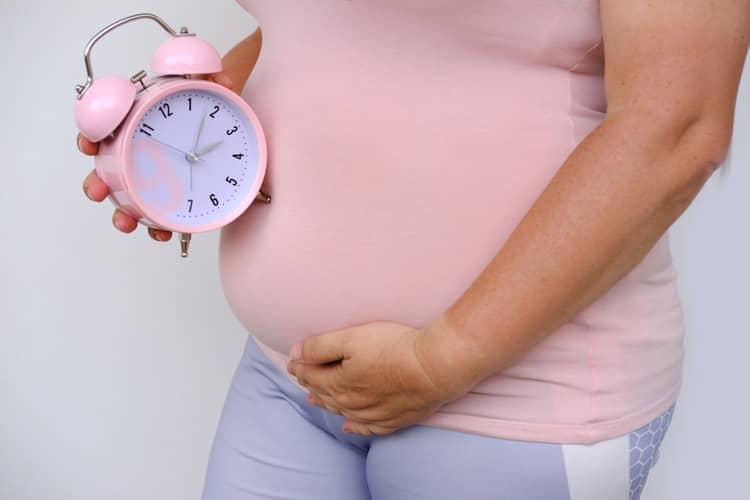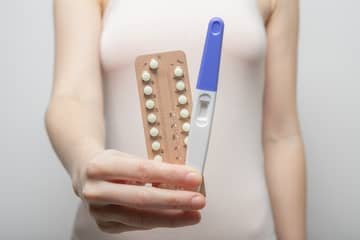
Contractions every 5 minutes. When to go to the hospital?
Contractions, their course, frequency, duration, pain and sensations. In connection with the arrival of the offspring into the world, contractions are definitely one of the most prominent symptoms of childbirth. When should you actually go to the hospital? Primiparous women are often interested in how contractions feel or how contractions hurt. Even in this case, however, it is still true that a hundred women and a hundred different experiences. Some pregnant women can even mistake real labor contractions. Specifically, it can be false contractions, also known as Braxton-Hicks contractions. How to recognize contractions? How do I know I'm having contractions? What are practice - false contractions?
Although it might seem that recognizing the signs of labor is really easy, for women who give birth for the first time it is a completely new situation and experience. Despite the symptoms that appear in practice, a woman may not always have the complete feeling that the child is asking about the world. After all, every woman experiences pregnancy, the phase before childbirth and the birth itself differently. In addition to other signs of labor, they are the real thing - labor contractions, which are a clear indicator. In the 3rd trimester, many women also tend to have so-called messengers. These are false contractions that train the muscles of the uterus and prepare it for childbirth. It often happens that women mistakenly consider them in the 3rd trimester as a sign of the beginning of labor. How to recognize contractions?
What are contractions?
Contractions are physiologically muscle contractions of the uterus. The uterus is a muscular organ that is active throughout pregnancy. She is getting bigger and her muscle tissues are also getting bigger. Contraction and release of the uterus is completely natural and can be described as muscle spasms. Contractions of the uterus occur during different stages of pregnancy, they can manifest themselves after physical exertion, when cleaning or lifting heavy objects, during walking or during increased activity of the fetus - movements of the baby in the abdomen. A frequent effect of uterine contractions is also the feeling of a hardening of the abdomen. Most women realize that the uterus as a muscular organ works throughout pregnancy only at the moment when real contractions occur, but false contractions can appear even earlier.
Contractions in the minds of many mothers cause fear and imagine them as unbearable pain. Again, each woman experiences and perceives them very individually. It is therefore difficult to accurately describe what labor contractions are compared to. It is necessary to distinguish at which stage of pregnancy the contractions appear. For some women, false contractions do not appear at all, for example. You can read below how to distinguish birth and false contractions.

True contractions - symptoms
Women's experiences with labor contractions are very different. Despite the fact that most women agree that it is a painful experience, some pregnant women can breathe through it better than others. The impulse for contractions itself is due to the hormone oxytocin. It is released and causes muscle contractions of the uterus and increases the pressure in the abdomen. If you are worried that you cannot distinguish between real and false contractions, we have some clear signs for you that your contractions are real and your task is to go to the hospital, because sooner or later the baby will start asking questions about the world.
In addition, true contractions are often accompanied by other symptoms characteristic of childbirth. As a rule, real contractions can appear after the 36th-37th week of pregnancy. If they came earlier, it could be signs of premature birth.
How do contractions hurt - feelings and symptoms
Compared to false contractions, real contractions are more intense, stronger and more painful. What are the contractions before childbirth compared to? Women describe them as very strong menstrual cramps. At the same time, the pain appears not only in one area of the lower abdomen. It is therefore not localized, it affects the entire lower abdomen and the pain shoots into the spine, pelvis, hips or thighs. The pain usually comes on suddenly and gradually subsides until the next contraction comes. How painful contractions are also depends on the pain threshold. Some parturients can breathe better during these intense contractions of the uterus, while others tolerate the pain worse. Closer to childbirth, the pain usually intensifies. It is also caused by the shortening of the interval between contractions.
There are also known pathological contractions of the uterus, in which the intensity is excessive or weak. In the maternity ward, the CTG device (monitors uterine contractions) will alert you to this. In such a case, it is necessary to act so that the fetus is not endangered. A sign of true contractions is also the fact that the pain does not subside when changing position, walking or taking a warm bath. As the pain of the cramps continues to increase, it is difficult for the woman to move or talk. The pain causes increased shortness of breath and the woman can feel the baby's movements due to its descent into the birth canal. The cervix gradually opens. It is fully open to 10 cm.

Contractions every 5 minutes - interval and duration
How do I know I'm having contractions? The best identifying sign is the interval of contractions. This symptom is also pointed out by doctors and midwives. It is the intensity and interval of the right contractions that is responsible for the opening of the cervix. Muscle contractions, the onset of contractions, appear at regular intervals. For example, contractions appear every 10 minutes and the interval shortens, a contraction every 7 minutes, 5 minutes or 3 minutes. An interval of every 10 minutes is usually considered by obstetricians as a signal that it is necessary to go to the hospital. Some say an interval of up to every 5 minutes.
The duration of one contraction usually ranges from 30 to 90 seconds. It is also customary that the pain of the contractions towards childbirth intensifies and the duration of the contraction increases. In this phase, the contractions are usually the most painful, because they follow each other quickly and last a long time. In total, contractions can last several hours. Usually, true labor contractions last no more than 12 hours. Of course, exceptions are relatively frequent, and some women experience contractions even longer. Before labor begins, practice contractions may appear, which may be more painful, but have no clear interval and do not indicate the progress of labor.
Other signs of labor
We can include a number of obvious signals to birth symptoms. Those, in combination with birth contractions, indicate that the time of birth is approaching. The individual symptoms have their own sequence, but the onset of the mentioned birth signals cannot be precisely ordered in time. These symptoms can appear within hours or even days. Some indicate preparation for childbirth and others already signal childbirth directly. However, it is essential to perceive them so that it is clear to the expectant mother that these are real signs of labor and that the trip to the maternity hospital should not be postponed unnecessarily. In the event of the occurrence of these symptoms, notify your gynecologist. Here are some of the most common symptoms:
- diarrhea before childbirth,
- increase in the frequency of occurrence of false contractions,
- displacement of the child lower into the birth canal,
- shooting dull pain in the back area,
- release of the mucus plug suddenly or gradually a few days before childbirth - vaginal discharge colored brown to pink,
- intense right contractions appear, the interval of which is shortened, if they appear gradually every 5 minutes and the contraction lasts approximately 60 seconds, this is a clear sign of labor,
- the cervix shortens, softens, expands and begins to open,
- the outflow of amniotic fluid in a rush or gradually – after the amniotic fluid package breaks, labor begins within a few hours (the child should not be without amniotic fluid for too long).

False contractions - symptoms
These so-called practice contractions are typical for the 2nd-3rd trimester of pregnancy. Some women feel them continuously from the 20th week, others 2 to 3 weeks before giving birth, and some do not experience them at all. There is no need to worry about false contractions. Many pregnant women are frightened by these uterine contractions, which is completely natural. However, there is no need to panic. Most women who experienced them tolerated the symptoms very well. Hardening of the abdomen and muscle contractions in a certain part of the abdomen are typical for Braxton-Hicks contractions. In the same way, if you have irregular contractions all day, know that you are guaranteed to be "found" by the messengers.
Braxton-Hicks contractions of the uterus represent the process of muscle contractions of the uterus, which prepare the uterus for real contractions. They also prepare the birth canal for the expected birth. In principle, this is a similar principle to true contractions, except that they do not fulfill the role of opening the cervix, are not as intense, painful and have different interval and time characteristics. They very often start after increased physical exertion, lifting loads or when changing position - calmly even during sleep. False contractions at night can surprise you. How to recognize false contractions?
How to feel false contractions - pain and sensations
False contractions are also much less intense based on women's descriptions. They usually cause discomfort, hardening of the abdomen and increased pressure in it. As a rule, they are described as painless. If painful false contractions appear for some women, the pain is usually localized in one place. In no case does the pain shoot into the spine or other parts of the body. Women who experienced them described them as a feeling of tension and tension in the front part of the lower abdomen or as very weak menstrual cramps.
They can occur at any time during the day, but quite often they appear in the afternoon or evening. In contrast to real contractions, you can try, for example, a warm bath, changing the position to the left side, drinking lukewarm - cold water, and these feelings of false contractions will disappear. Conversely, right contractions do not subside. During false contractions, a woman can move and talk. False contractions do not cause changes in the organism in any way, they just prepare the body for childbirth. They are not accompanied by any other symptoms indicating childbirth.

False contractions - interval and duration
Similar to true contractions, the interval and intensity of contractions are a great indicator. Especially for first-time women who have never experienced false contractions, this feeling can be confusing and the nature of the pain may not be decisive. It is therefore important to note that false contractions do not have their regularity. Their onset and intervals between uterine contractions are different, while they are not shortened.
Often they can appear 4 times in an hour or 2 times in half a day. However, they should not be more often than 8 times a day. Their onsets are unpredictable and irregular. The contraction itself, a tightening sensation or a slight pain in the lower abdomen can last 30 seconds or up to 2 minutes. False contractions gradually subside and may return in a few hours or days.
How to induce contractions?
If you are due to give birth or are even pregnant, but the contractions still haven't come, there are several known procedures that can help induce contractions and thus start the entire birth process. Increased physical exertion, walking up stairs (with supervision), long walks are recommended. What you had to restrict until now can now cause contractions to occur. Treat yourself, for example, to mildly spicy food, which can irritate the intestines and uterus and cause contractions. Fresh ginger can also have a similar effect. Tea made from alchemy or raspberry leaves can be effective in inducing labor.
Sexual intercourse or massage in cooperation with a partner? Although sex is probably the last thing on your mind, what got you into this situation can help get the contractions going. Also, massage of the nipples or the perineum (the part between the anus and the back vaginal wall) can be helpful.
In some women, the artificial administration of oxytocin is used, which results in the induction of contractions. Women who were given artificial oxytocin often reported that the pain was much stronger, more intense, and breathing techniques during childbirth did not help.

Labor contractions - experience
A woman is a different experience. Several women describe labor contractions as a dull or spasmodic pain. They compare it to the process of starting heavy menstruation. Very often, women report that pain from contractions shot into their spine. They gradually perceived them as the onset of painful waves. Sometimes the pain was sharp, but it subsided until the arrival of another strong contraction. Many women report that it is normal for the abdomen to harden and strong pressure on the anus. Some women recommend going to the hospital if the interval between contractions is every 5 minutes.
The most frequent questions - FAQ
Are contractions in pregnancy the biggest scare for you? Do you have trouble managing pain? Read how to recognize contractions, how contractions hurt and what it means if irregular contractions occur throughout the day. If you have experienced false contractions or labor contractions before giving birth, we would appreciate it if you could describe to us what feelings you experienced. Share your experience in the discussion below the article.
How do I know I'm having contractions?
How do contractions hurt?
How to induce contractions?
How to recognize contractions?
I have contractions, when should I go to the hospital?
Pridať komentár





